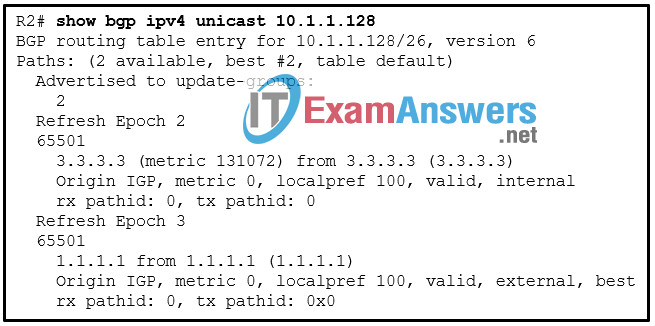Refer to the exhibit. A network administrator issues the show bgp ipv4 unicast 10.1.1.128 command on router R2 to verify the network 10.1.1.128 in the BGP table. The administrator notices that there are two paths to reach the network and the path through the neighbor 1.1.1.1 is the best-path. Which configuration step will allow the administrator to change the best path to use neighbor 3.3.3.3?

- Set the multi-exit discriminator to 75 for the path through 3.3.3.3.
- Set the origin code to i for the path through 3.3.3.3.
- Set the local preference to 200 for the path through 3.3.3.3.
- Change the metric value from 131072 to 32768 for the path through 3.3.3.3.
Explanation: Cisco routers review BGP attributes in the following ranked order when deciding which path is the best-path:
- Prefer the highest weight .
- Prefer the highest local preference .
- Prefer the route originated by the local router.
- Prefer the path with the shorter Accumulated Interior Gateway Protocol (AIGP) metric attribute.
- Prefer the shortest AS_Path .
- Prefer the lowest origin code.
- Prefer the lowest multi-exit discriminator (MED).
- Prefer an external path over an internal path.
- Prefer the path through the closest IGP neighbor .
- Prefer the oldest route for EBGP paths.
- Prefer the path with the lowest neighbor BGP RID .
- Prefer the path with the lowest neighbor IP address .
The first path attribute to be checked is the weight. In this case, no weight is listed because both routes are using the default value 0. The next path attribute to be checked is the local preference. A higher value is better. Therefore, setting the local preference to 200 will make the path through 3.3.3.3 the best-path.
Exam with this question: CCNP ENARSI v8 Certification Practice Exam
Exam with this question: CCNP ENARSI v8 Final Exam Answers
Please login or Register to submit your answer
